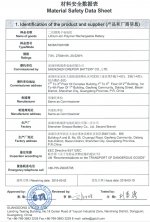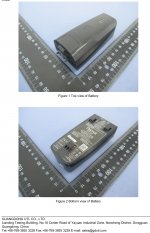Welcome to our Community
Wanting to join the rest of our members? Feel free to sign up today.
Sign up
You are using an out of date browser. It may not display this or other websites correctly.
You should upgrade or use an alternative browser.
You should upgrade or use an alternative browser.
What you should know about Anafi batteries
- Thread starter Gipsz Jakab
- Start date
Fmaxii
Well-known member
Yes it is, but the size is the size of one cell only. You can also see the size written on the battery.
Where did you find?Can anyone confirm the following about the ANAFI battery cells ?
- The Chinese manufacturer is Grepow, their Reference is GRP030072.
- They are 8C Discharge batteries.
- The dimensions of the 2 cells are 72 mm x 30 mm x 9.7 mm (The first line of this table)
View attachment 5108
Is it possible to buy from it?
Fmaxii
Well-known member
It looks like you missed one thread:
 parrotpilots.com
parrotpilots.com
For now, no way to buy somes.
Anafi Cells manufacturer
Not easy to find, but just found it. The manufacturer of our battery MCBAT00019B and battery cells is Grepow: http://reestrinform.ru/reestr-declaratcii-sootvetstviia/id20-reg_number-%D0%A0%D0%9E%D0%A1%D0%A1_CN.%D0%90%D0%9250.%D0%9400494.html the cell reference is : GRPA030072...
For now, no way to buy somes.
AnafiPilot1
Well-known member
- Joined
- Aug 15, 2019
- Messages
- 500
- Reaction score
- 385
I have got some coming to me very soon for testing - if there is interest I will stock them on our company website.
The cells are very cheap, however shipping LiPo cells is not! - so I have got my shipping manager looking at shipping options for sending cells out.
The cells are very cheap, however shipping LiPo cells is not! - so I have got my shipping manager looking at shipping options for sending cells out.
MustangPhil
Well-known member
The original manufacturer Grepow as well as the reference of the article is also mentioned in the pdf document that was published by Parrot for homologation purposes and collected by @Agustine in another thread.
I’ve got a cousin who’s job is to trade batteries (looots of them).
Depending on other findings or difficulties for shipping I may ask him to check if we can get his company to distribute them in European selling points.
On the last image of the report (the one with the cell), you see printed on the cell : A03072. That’s the size of the cell 30 mm x 72 mm. The reference of the cell in Grepow table of my previous post is GRPA030072...
parts of the report :



I’ve got a cousin who’s job is to trade batteries (looots of them).
Depending on other findings or difficulties for shipping I may ask him to check if we can get his company to distribute them in European selling points.
On the last image of the report (the one with the cell), you see printed on the cell : A03072. That’s the size of the cell 30 mm x 72 mm. The reference of the cell in Grepow table of my previous post is GRPA030072...
parts of the report :



Last edited:
I think with a short artificial load and measurement before starting to charge, the BMS determines the current charge of the battery and then starts charging. This may be a short flashing of the LEDs after the USB connection and only then will it indicate the level.I am having trouble getting my head around the charge in v charge out method of calculating the % battery left. I understand that the software can calculate the amount of charge put into the battery, provided that the USB-C connector is used and it is not charged via the battery connectors as some aftermarket chargers appear to do. But to calculate the actual charge in the battery it must know how full it was before charging started. Is that figure based on the resting voltage before charging or us their an internal table in the firmware that tracks each battery? I also assume that the Maximum Battery Capacity is also calculated from that figure.
The same workload drains the battery when stored for a long time at a high charge level ...
(The goodness of the battery cannot be determined from the voltage alone, because the charges slowly migrating to the electrodes create the voltage and we would find it okay to measure it. By comparing this voltage drop with the initial voltage, the battery charge can be determined, and the internal resistance measurement during load gives the condition of the battery, which is displayed in FF6%.
This value may increase slightly, because the oxides and compounds formed during storage dissolve during use.)
I have a ponderance to add here and curious if anyone knows the answer. We have a handful of Anafis at work and fly several other systems as well. Two of the other systems we fly need to have the battery BMS calibrated periodically. Parrot from what I have seen say nothing about this and no one does it. The purpose on the others is that the BMS over time drifts what it believes 0% to be. We train our pilots to always land at 20% but over time the BMS drifts 0% towards 20%. By calibrating the battery it resets the BMS to accurately report the %. I can easily troubleshoot this with the other systems but Anafi doesn’t have any way that I have found. I ponder if this might be a portion of the issue with Anafi batteries these days.
Since all my batteries are above 97% in condition, I can’t try them, but I think they need to be solved similarly to mobile phones. For mobiles, the battery.stat file must be deleted and charged and discharged 2-3 times up to 100% -0%.I have a ponderance to add here and curious if anyone knows the answer. We have a handful of Anafis at work and fly several other systems as well. Two of the other systems we fly need to have the battery BMS calibrated periodically. Parrot from what I have seen say nothing about this and no one does it. The purpose on the others is that the BMS over time drifts what it believes 0% to be. We train our pilots to always land at 20% but over time the BMS drifts 0% towards 20%. By calibrating the battery it resets the BMS to accurately report the %. I can easily troubleshoot this with the other systems but Anafi doesn’t have any way that I have found. I ponder if this might be a portion of the issue with Anafi batteries these days.
I would try to hard reset the fully discharged battery and charge it to 100% immediately. If the BMS is reset and the battery is charged to 100%, it will be 0%, counting backwards.
Since total depletion is harmful, this is just a theory, everyone should test it at their own risk.
D
Deleted member 3201
Guest
You could turn on the Anafi at home, and just let it idle for about 2 hours before it turns itself off when the voltage gets too low. After that you wait a few minutes and then charge it to 100 I guess
I guess what could be the reason that BMS is wrong.
It monitors (calculates) the energy charged in the battery when charging. When draining, the same amount is the basis for the level indication (count the same amount back). As long as the battery is working well, it will show the remaining charge correctly. The problem begins when the energy supplied to a worn (damaged) battery is converted into heat. The BMS also counts this energy, but it is not stored. This causes a shortage when discharged. Because of this, it shows that there is 20% left while the battery is empty.
I don't think this problem would occur if the BMS measured the internal resistance and reduced the calculation of the stored energy accordingly (because it's not in the battery, it's converted to heat)
It monitors (calculates) the energy charged in the battery when charging. When draining, the same amount is the basis for the level indication (count the same amount back). As long as the battery is working well, it will show the remaining charge correctly. The problem begins when the energy supplied to a worn (damaged) battery is converted into heat. The BMS also counts this energy, but it is not stored. This causes a shortage when discharged. Because of this, it shows that there is 20% left while the battery is empty.
I don't think this problem would occur if the BMS measured the internal resistance and reduced the calculation of the stored energy accordingly (because it's not in the battery, it's converted to heat)
Rafaelgpinto
Member
- Joined
- Aug 7, 2018
- Messages
- 10
- Reaction score
- 0
How to proper charge the Anafi batteries? I would like to have those multi USB chargers, charging at same time the 3 batteries. Do you have any recommendation? How to monitor the charge during the flight? Or at least on a computer?
I have already summarized it in the opening post. These are worth following.How to proper charge the Anafi batteries? I would like to have those multi USB chargers, charging at same time the 3 batteries. Do you have any recommendation? How to monitor the charge during the flight? Or at least on a computer?
What you should know about Anafi batteries
What you should know about Anafi batteries: Type of LiHV is a high voltage Lithium polymer 2 cells / battery = 2S (2 are connected in series) Max. capacity 2700mAh Max. cell voltage 4.35V / cell 8.7V / package (LiPo 4.2V 8.4V / package) Nominall voltage 3.8V / cell (LiPo 3.7V / cell) 7.6V /...
Freeflight 6 mod app - With Special Features
I have been working on modding FF6 with some of the extra (special) features they are offering for the US army and USA version of the Anafi. Since the 1st day of owning the Anafi - mapping has been an weak point in the App, the need for online maps and the fact that you cannot preload large...
ctrl-Felix
Member
- Joined
- Apr 14, 2021
- Messages
- 5
- Reaction score
- 2
I just received my first parrot anafi (it's also my first drone) and I tried to inform myself about the best practices to maintain the battery. I found this super useful thread (thank you very much for that). Now I still have a question regarding the 'post-flight' situation. You said if it's under 20% you would recommend to charge it to about 65%. If I have at about 25-40% remaining battery would it also be better to charge it a bit (to 65% - I think it should be loading them until the fourth green light starts flashing) or just keep them as they are. And I guess it's also always better to just charge them shortly before the flight to not have them at 100% too long.
Last edited:
Thank you for the praise!I just received my first parrot anafi (it's also my first drone) and I tried to inform myself about the best practices to maintain the battery. I found this super useful thread (thank you very much for that). Now I still have a question regarding the 'post-flight' situation. You said if it's under 20% you would recommend to charge it to about 65%. If I have at about 25-40% remaining battery would it also be better to charge it a bit (to 65% - I think it should be loading them until the fourth green light starts flashing) or just keep them as they are. And I guess it's also always better to just charge them shortly before the flight to not have them at 100% too long.
The answer to your question is included in my 1st post:
If it is still below 20%, it is recommended to charge it to at least 60-65% 3.8V / cell (7.6V / pack) within 20 minutes (For example with a powerbank, on the spot)
Low voltage below 20% is not good for the battery. It is worth buying a powerbank of at least 10,000mAh and if it still below than 20%, you can charge it up to 30-40% on the spot.
65% charge recommended to long (winter) storage.
Each of the LEDs indicates 25% when lit continuously and an intermediate value when flashing.
Last edited:
D
Deleted member 3201
Guest
ctrl-Felix
Member
- Joined
- Apr 14, 2021
- Messages
- 5
- Reaction score
- 2
I don't know in which thread but there was a discussion about that somewhere in this forum.within 20 minutes? Parrot says you should NOT charge for AT LEASt 20 minutes
The result was that by using a powerbank (low current) you aren't creating much heat and so the battery can still cool down after the flight. Those 20 minutes are the time gap in which the battery should cool down as heat isn't that good. The most important point is that probably staying below 20% damages the battery more than the little bit of heat the powerbank generates.
D
Deleted member 3201
Guest
People on this forum actually believe that old firmwares cannot crash... think about that for a few seconds. Would you trust those kind of “experts” to educate you on battery maintenance ??I don't know in which thread but there was a discussion about that somewhere in this forum.
The result was that by using a powerbank (low current) you aren't creating much heat and so the battery can still cool down after the flight. Those 20 minutes are the time gap in which the battery should cool down as heat isn't that good. The most important point is that probably staying below 20% damages the battery more than the little bit of heat the powerbank generates.
ctrl-Felix
Member
- Joined
- Apr 14, 2021
- Messages
- 5
- Reaction score
- 2
Most of those points are just about the functionality of LiPos. For example a voltage below 3.5 is already starting processes which damage the battery. This can be verified through other source too. And it's obvious that Parrot has a problem with it's software showing the remaining capacity on the battery. If those tips actually help me to avoid a crash, why not using them? As already said, literally every claim can be verified through third party sources.People on this forum actually believe that old firmwares cannot crash... think about that for a few seconds. Would you trust those kind of “experts” to educate you on battery maintenance ??
As it is not advisable to charge it when it is hot, you should wait until it cools down and then not leave it on low voltage for a long time.within 20 minutes? Parrot says you should NOT charge for AT LEASt 20 minutes
Of course, this is not scripture, do as you like. It is just a logical conclusion that science shows that the best storage for LiPo and LiHV batteries is 65% charge. Because it is damaging to 100% charge and damaging to full discharge. This is the correct treatment: charge before flying so you don't have to keep it at 100% for long, and don't discharge it below 20%, but if you do, charge it to 65% as soon as possible.
Last edited:
Similar threads
- Replies
- 6
- Views
- 4K
- Replies
- 12
- Views
- 6K
- Replies
- 102
- Views
- 32K
- Replies
- 20
- Views
- 10K



